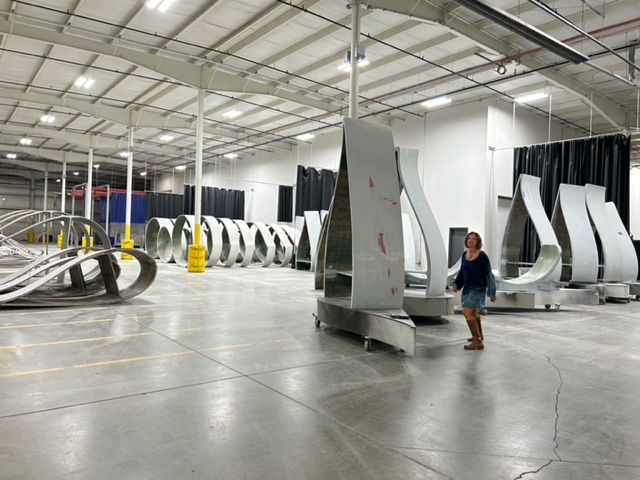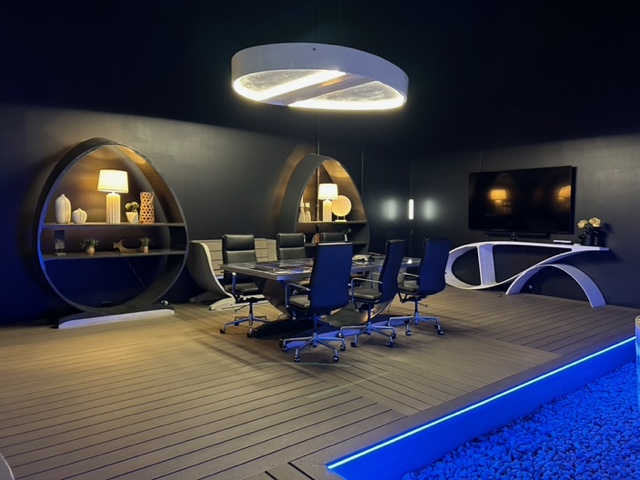Blade’s Edge: An Artistic Approach to Wind Power’s Dirty Secret

A line of wind turbines traces perfect circles in the distance.
For many of us, the scene borders on romantic: Clean fresh wind rotates graceful blades, then a network of magical machines and wires transforms this gift from Mother Nature into fuel that powers everything from our electronic devices to life saving medical equipment.
As usual, it comes at a cost. Bird strikes, noise considerations, and visual blight are just some of the points cited by those who oppose wind development. There is another drawback: What do you do with the thousands of blades retired annually?
It’s no small problem. While wind generates about 10 percent of our electricity, it also generates thousands of tons of blade waste (estimated to reach 43 million tons by 2050). Consisting mainly of fiberglass, balsa wood, and epoxy, turbine blades are a challenge to recycle. They’re between 100 and 300 feet long, weigh up to 30,000 pounds, and last 10–20 years. People are burying blades in Casper, Wyoming; shredding them in Louisiana, Missouri; and suing each other over them in Sweetwater, Texas.
In Avon, Ohio, however, a new company is turning those massive blades into weird and wonderful objects that feature custom art.

At Canvus, the concept is simple: Saw retired blades into manageable sections and turn them into functional objects. To the readers rolling their eyes over yet another project aimed at artwashing some dreadful detritus our species generates, the company’s Vice President of Corporate Affairs Brian Donahue says this:
“We spent three years working on this solution. We wanted to make sure we could actually do this on a mass scale because it is a big problem,” he says. “Even before we turned a bolt on a machine and set up the plant, we wanted to make sure our designs were sustainable,” he adds. “We wanted to make sure we weren’t a science fair project or a garage band.”
The company’s output is neither of those things. These funky benches, swings, tables, fountains, planters, etc. are so substantial that when you enter the Canvus showroom, Director of Experience Savannah Kowalski will tell you, “If you can lift it, you can take it.”

While the lines of blade components waiting for transformation look otherworldly, a walk through the plant removes some of the mystique. “We take the blade, cut it into slices—basically like a piece of bread—and then we turn that piece into a product.”
Each piece’s design is determined by the shape of the decommissioned blade, producing benches that evoke an altar, swings suspended inside circles, and free-form planters, among others. The nature of the products, which weigh hundreds of pounds, is uniquely suited to public spaces. And while the blade may have been retired from use on a turbine, it still has plenty of life left as one of Canvus’s creations.
“Our products are maintenance free and can last 25+ years,” says Kowalski, noting the non-blade components (composite lumber, recycled rubber, mixed plastics) the company uses for things such as table tops and seats have recycling stories of their own.
Canvus’s products also provide a unique opportunity for area artists. After all, every one of these things is just screaming to be adorned with, well, art. To that end, they’ve sponsored PAR events (Primed And Ready), in which a group of artists descend upon the studio space within the company’s nearly 110,000 square-foot production facility in Avon and customize a piece of furniture, usually the willow.
“We’re starting with Cleveland artists,” says Kowalski. “We’re also excited to work with national artists as well—and artists from all over.”

Thus far, more than a dozen artists have participated. Mike Sobeck created a pizza bench, while Alicia Vasquez imagined a dragonfly sky for her unit, and Debra Sue Solecki employed a water lily scene for her design, rise above, with inspirational messages on the structure’s interior.
“I wanted to do something beautiful from nature on the outside,” says Solecki, “but I also was like, when you’re sitting in this I wanted to give this positive feeling,” she adds, “it’s like a little cocoon of positive energy—because I just think [Canvus’s] mission in general is just really positive.”
Solecki continues: “As an artist it was my favorite project I’ve ever worked on because of the creative freedom and the support,” she says, citing fair compensation and a nurturing atmosphere.
Launched with private funding, Canvus’s business headquarters are in Rocky River while the manufacturing arm moved into the Avon facility in November 2022. Since then, they’ve shipped units to Minnesota, Wisconsin; and even Cleveland’s own Great Lakes Science Center among other locations.
The business model is unique to say the least.
“Cities can absolutely call and buy direct,” says Donahue, adding that the units aren’t really appropriate for the retail/residential market due mainly to their weight. “It really is furniture made for large public spaces to amplify those spaces,” he adds, “so we don’t sell to the consumer market directly.”
The bulk of Canvus’s business is based on a donor network. If the requesting entity (usually a municipality or non-profit organization such as a public park system) is not already aligned with a benefactor, Canvus staff endeavors to match them up with one that has come to the table to support this mission.
“On the backside, our donors are all different sizes, but mainly we go after Fortune 1000 companies including the energy companies who have these blades coming down,” says Donahue.
“A donor’s going to participate for one of three reasons,” he says, first tagging a community connection, “meaning they have operations there or an office there.” He continues, “Number two is a material connection; so if you’re generating blade waste and we’ve solved the problem, you should step up and participate in buying these products and donating them as part of the solution. It’s a great financial benefit because it’s a charitable donation and it’s also a PR coup,” he says, adding the blade waste narrative has not been good for industry. “This is a great way to shift that.”
Donahue explains: “Every time a donation is received by a community, it’s a PR event,” he says. “I think it will grow really nicely and organically as people see what these can do to their spaces and their communities.”
The third reason a donor might come on board, says Donahue, is when they share a social connection that’s aligned with Canvus’s mission and objectives, namely amplifying public spaces with objects that add up to a bit more than the sum of their parts, however abstractly.
Solecki is glad to be one of those parts. “I love the pieces being in public spaces and bringing awareness to the environmental issue, but not in in a negative way,” she says. “People can solve these problems.”
“… in a beautiful, functional, art way,” adds Kowalski.


You must be logged in to post a comment.